

Favorite Flipped Video Tools - Graphite. Personal Connections - The Best Way To Engage Students In Distance Learning Environment. Knowing the material is not enough.
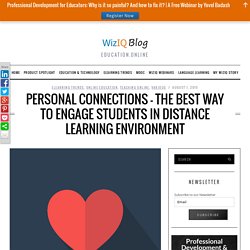
For student achievement, relationships are essential. In my classes, I work to nurture both my relationships with my students and with their parents. I do this because: Students work harder if they believe that they can please the teacher. If You Are A Learning Architect (#xAPI) If you are a learning architect, how will you design an ideal learning experience?
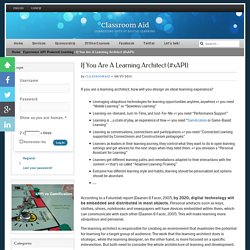
According to a Futurelab report (Daanen & Facer, 2007), by 2020, digital technology will be embedded and distributed in most objects. Personal artefacts such as keys, clothes, shoes, notebooks and newspapers will have devices embedded within them, which can communicate with each other (Daanen & Facer, 2007). PadwheelposterV3.pdf. TOS_Guidance_Jan%202015_0.pdf. Mobile.ipadinsight. So, you’ve got an iPad and it’s starting to get a little slow on you.
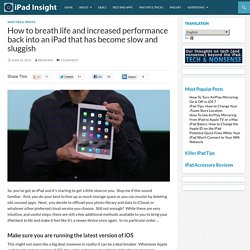
Stop me if this sound familiar– first, you do your best to free up as much storage space as you can muster by deleting old, unused apps. 60 Math Teachers & Experts Reveal 3 Favourite Math Apps and Tools For Teaching. Do you think you need a dozen tools for teaching math in your classroom?
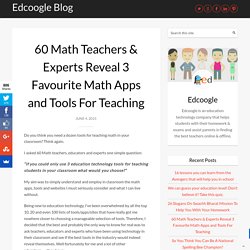
Think again. I asked 60 Math teachers, educators and experts one simple question: “If you could only use 3 education technology tools for teaching students in your classroom what would you choose?” My aim was to simply understand and employ in classroom the math apps, tools and websites I must seriously consider and what I can live without. Why education needs more fuzzy thinking - News. Last Updated:29 May, 2015Section:News As the future becomes increasingly unknowable, we must abandon a rigid hierarchy of subjects for a flexible yet ambitious approach I’ve just finished planning a new course.
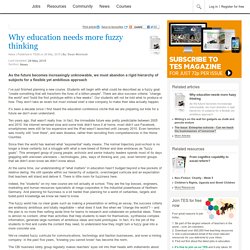
Students will begin with what could be described as a fuzzy goal: “create something that will transform the lives of a billion people”. There are also success criteria: “change the world” and “build the first prototype within a few weeks”. Our students will not be told what to produce or how. It’s been a decade since I first heard the education conference cliché that we are preparing our kids for a future we don’t even understand. Ten years ago, that wasn’t really true. Teaching With Educational Videos - Journey Parenting. Educational videos can make a big impact in the classroom, as long as you knowhow to draw out the value of the experience.
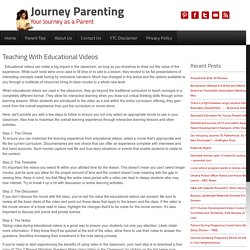
While such tools were once used to fill time or to add to a lesson, they tended to be flat presentations of interesting concepts made boring by monotone narrators. Much has changed in this arena and the options available to you through a multitude of resources bring in-class movies to a whole new level. When educational videos are used in the classroom, they go beyond the traditional curriculum to teach concepts in a completely different format. They allow for interactive learning when you draw out critical thinking skills through active learning lessons. When students are introduced to the video as a tool within the entire curriculum offering, they gain more from the overall experience than just the curriculum or movie alone.
Youth Media International. By Soraya Shockley Remember when a TI-84 was the most technologically advanced tool in the classroom?

I don’t! Tech has always been a part of my high school reality. But as digital and traditional learning mix and mingle, reactions have exploded over whether education technology, or “ed tech,” is enhancing or hindering education. On this question, we usually hear from teachers, parents, administrators, tech companies, and investors clamoring to fund them. 21 Educational Apps Approved By Teachers. Ed Tech Tools. Cartooning. Making Ed-Tech Predictions: The 2015 Edition. 4 min read This post first appeared on Educating Modern Learners in January 2015 Although I spend a lot of time looking at the past and the present of education technology, I'm just not that good at predicting the future.

Back in January 2012, for example, I wrote a New Year's blog post predicting that Google would cancel its Chromebooks program. I mean, the company does have a horrible track record for scrapping some well-beloved tools. But adoption of Chromebooks, particularly by schools, has skyrocketed in the past three years, and I don't think Google's Chrome OS is in any danger (for the time being, at least). That highlights the challenge of making predictions about the future of education technology. Evidence for Various Research-based Instructional Strategies: Countering Critiques.
There are several bloggers continuing to criticize constructivist-inspired teaching methods.
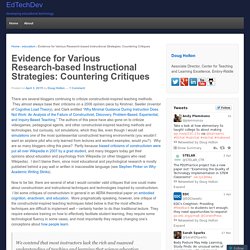
They almost always base their criticisms on a 2006 opinion piece by Kirshner, Sweller (inventor of Cognitive Load Theory), and Clark entitled “Why Minimal Guidance During Instruction Does Not Work: An Analysis of the Failure of Constructivist, Discovery, Problem-Based, Experiential, and Inquiry-Based Teaching.” The authors of this piece have also gone on to criticize videogames, pedagogical agents, and other constructivist-inspired teaching methods and technologies, but curiously, not simulations, which they like, even though I would call simulations one of the most quintessential constructivist learning environments (you wouldn’t want an airplane pilot who only learned from lectures and worked examples, would you?).
The Future of Personalized Learning is Now. Jean Fleming Call it personalized, differentiated or customized—teachers have long dreamed of an education system that lets them deliver the exact instruction a child needs at the exact right time to foster optimal learning and growth.
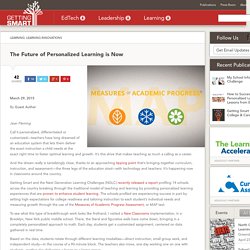
It’s this drive that makes teaching as much a calling as a career. And the dream really is tantalizingly close, thanks to an approaching tipping point that’s bringing together curriculum, instruction, and assessment—the three legs of the education stool—with technology and teachers. It’s happening now in classrooms around the country. Getting Smart and the Next Generation Learning Challenges (NGLC) recently released a report profiling 14 schools across the country breaking through the traditional model of teaching and learning by providing personalized learning experiences that are proven to enhance student learning. (Why) Does Your Education Website Collect Information about Visitors? 3 min read Earlier this year, the Associated Press broke a story that HealthCare.gov was “quietly sending consumers’ personal data to private companies that specialize in advertising and analyzing Internet data for performance and marketing.”
The site had Google Analytics and Twitter and Facebook sharing buttons installed. Chances are, your website is doing the very same thing.
Capture Student Work with Seesaw – The Learning Journal. 24 Jan I’m very excited about the new learning journal app Seesaw which can help teachers and parents connect with students and keep track of their school work. Seesaw is a simple way for students as young as 5 to independently document what they are learning at school. It empowers students to take more ownership of their learning. Seesaw gives parents a personalized, up-to-date window of what their child is doing and learning at school. It has a visual format that parents can easily follow and crosses language barriers too. Learn more by visiting their website! 6 elements of a successful iPad implementation. By Samantha Messier and Stephanie Schroeder 11/17/2014 Topics: Mobile Learning, 1-to-1, Professional learning As more districts across the United States move to 1:1 initiatives, a common barrier is financial resources, and a common temptation is to regard these initiatives as technology enterprises rather than instructional transformations.
In a three-year pilot project, the Boulder Valley School District (BVSD) addressed these challenges by implementing a creative approach designed to entice public funders by providing all students with equitable access to digital devices. A key feature of our model was synergy among multiple, interdependent program elements: Community engagement A strong instructional model Digital devices and apps for students Logistical support Guidance toward high-leverage resources Ongoing, embedded professional development None of these elements alone is sufficient.
Seeking the unique pedagogical characteristics of video. Video Tools. Ed Tech. Access Ed Tech. Twitter Ed Tech Blogs. Ed Tech WIKIS. ICT-Tools. Jing - A free tool to capture Images & Video. How to Quickly Create a Video on Magisto. Five Ways to Create and Use QR Codes In Your Classroom. As I do every year, I am taking this week to relax, recharge, and ski with friends. While I'm away I will be re-running the most popular posts of the year. This was the second most popular post in March, 2014. Recently, through the Free Technology for Teachers Facebook page I was asked for suggestions for tools for creating QR codes. Here are five suggestions that I often make in regards to creating and using QR codes in classrooms. Russel Tarr developed the QR Treasure Hunt Generator. Goo.gl is Google's URL shortening tool. QR Droid's QR Code Generator allows you to create QR codes that link to websites, chunks of text, phone numbers, email addresses, contact information, calendar events, and location coordinates.
QR Voice is a free tool that allows you to create QR codes that when scanned will play a short audio message. TagMyDoc is a tool that allows you to apply a QR code to Word documents and PDFs that are stored on your computer.